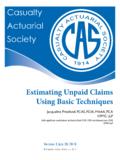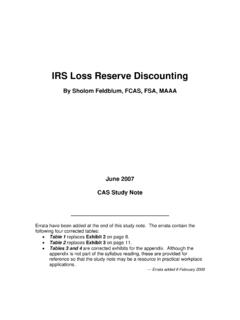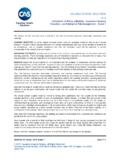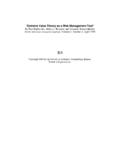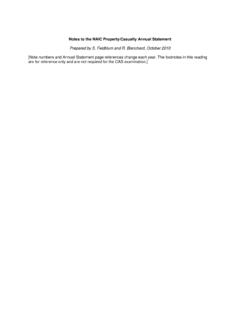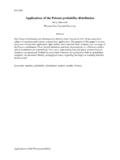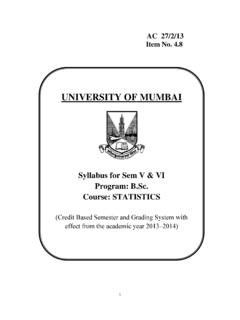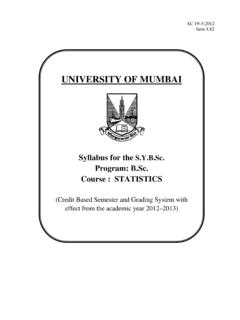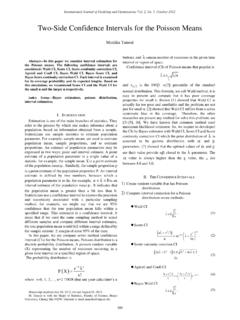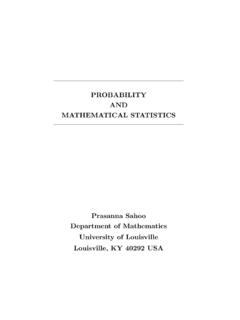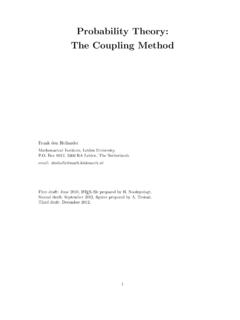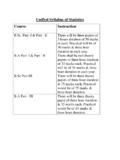Transcription of An Introduction to Risk Measures for Actuarial Applications
1 EDUCATION AND EXAMINATION COMMITTEE OF THE SOCIETY OF ACTUARIES CONSTRUCTION AND EVALUATION OF Actuarial MODELS STUDY NOTE AN Introduction TO RISK Measures FOR Actuarial Applications by Mary R. Hardy, PhD, FIA, FSA CIBC Professor of Financial Risk Management University of Waterloo Copyright 2006 Mary R. Hardy. Reproduced by the Casualty Actuarial Society and the Society of Actuaries with permission of the author. The Education and Examination Committee provides study notes to persons preparing for the examinations of the Society of Actuaries. They are intended to acquaint candidates with some of the theoretical and practical considerations involved in the various subjects. While varying opinions are presented where appropriate, limits on the length of the material and other considerations sometimes prevent the inclusion of all possible opinions.
2 These study notes do not, however, represent any official opinion, interpretations or endorsement of the Society of Actuaries or its Education and Examination Committee. The Society is grateful to the authors for their contributions in preparing the study notes. C-25-07 Printed in An Introduction to Risk Measures for ActuarialApplicationsMary R HardyCIBC Professor of Financial Risk ManagementUniversity of Waterloo1 IntroductionIn Actuarial Applications we often work with loss distributions for insurance products. Forexample, in P&C insurance, we may develop a compound Poisson model for the lossesunder a single policy or a whole portfolio of policies. Similarly, in life insurance, we maydevelop a loss distribution for a portfolio of policies, often by stochastic and loss distributions are also important in banking, and most of the risk measureswe discuss in this note are also useful in risk management in banking.
3 The conventionin banking is to use profit random variables, that isYwhere a loss outcome would beY <0. The convention in insurance is to use loss random variables,X= Y. In thispaper we work exclusively with loss distributions. Thus, all the definitions that we presentfor insurance losses need to be suitably adapted for profit random , it is usually appropriate to assume in insurance contexts that the lossXis non-negative, and we have assumed this in Section of this note. It is not essentialhowever, and the risk Measures that we describe can be applied (perhaps after someadaptation) to random variables with a sample space spanning any part of the real established a loss distribution, either parametrically, non-parametrically, analyti-cally or by Monte Carlo simulation, we need to utilize the characteristics of the distributionfor pricing, reserving and risk management.
4 The risk measure is an important tool in risk measure is a functional mapping a loss (or profit) distribution to the real we represent the distribution by the appropriate random variableX, and letHrepresentthe risk measure functional, thenH:X RThe risk measure is assumed in some way to encapsulate the risk associated with a first use of risk Measures in Actuarial science was the development ofpremium prin-ciples. These were applied to a loss distribution to determine an appropriate premiumto charge for the risk. Some traditional premium principle examples includeThe expected value premium principleThe risk measure isH(X) = (1 + )E[X]for some 0 The standard deviation premium principleLet V[X] denote the variance of theloss random variable, then the standard deviation principle risk measure is:H(X) = E[X] + V[X]for some 0 The variance premium principleH(X) = E[X] + V[X]for some 0 More premium principles are described in Gerber (1979) and B uhlmann (1970).
5 Clearly,these Measures have some things in common; each generates a premium which is biggerthan the expected loss. The difference acts as a cushion against adverse difference between the premium and the mean loss is the premium loading. In thestandard deviation and variance principles, the loading is related to the variability of theloss, which seems developments have generated new premium principles, such as the PH-transform(Wang (1995, 1996)), that will be described below. Also, new Applications of risk measureshave evolved. In addition to premium calculation, we now use risk Measures to determineeconomic capital that is, how much capital should an insurer hold such that the uncertain2future liabilities are covered with an acceptably high probability?
6 Risk Measures are usedfor such calculations both for internal, risk management purposes, and for regulatorycapital, that is the capital requirements set by the insurance addition, in the past ten years the investment banking industry has become veryinvolved in the development of risk Measures for the residual day to day risks associatedwith their trading business. The current favorite of the banking industry is Value-at-Risk,or VaR, which we will describe in more detail in the next Risk Measures for Capital Example Loss DistributionsIn this Section we will describe some of the risk Measures in current use. We will demon-strate the risk Measures using three examples: A loss which is normally distributed with mean 33 and standard deviation A loss with a Pareto distribution with mean 33 and standard deviation A loss of 1000 max(1 S10,0), whereS10is the price at timeT= 10 of someunderlying equity investment, with initial valueS0= 1.
7 We assume the equityinvestment price process,Stfollows a lognormal process with parameters = = This means thatSt lognormal( t, 2t). This loss distribution hasmean value , and standard deviation This risk is a simplified version ofthe put option embedded in the popular variable annuity these loss distributions have the same first two moments, the risks are actuallyvery different. In Figure 1 we show the probability functions of the three loss distributionsin the same diagram; in the second plot we emphasize the tail of the losses. The verticalline indicates the probability mass at zero for the put option are not assuming any hedging of the risk. This is the naked Density FunctionLognormal Put OptionNormalPareto40060080010000 e+002 e 044 e 046 e 04 Lognormal Put OptionNormalParetoLossProbability Density FunctionFigure 1: Probability density functions for the example loss Value At Risk the Quantile Risk MeasureThe Value at Risk, or VaR risk measure was actually in use by actuaries long before it wasreinvented for investment banking.
8 In Actuarial contexts it is known as the quantile riskmeasure or quantile premium principle. VaR is always specified with a given confidencelevel typically =95% or 99%.In broad terms, the -VaR represents the loss that, with probability will not be ex-ceeded. Since that may not define a unique value, for example if there is a probabilitymass around the value, we define the -VaR more specifically, for 0 1, asH[L] =Q = min{Q:Pr[L Q] }(1)For continuous distributions this simplifies toQ such thatPr [L Q ] = .(2)That is,Q =F 1L( ) whereFL(x) is the cumulative distribution function of the lossrandom reason for the min term in the definition (1) is that for loss random variables that arediscrete or mixed continuous and discrete, we may not have a value that exactly matchesequation (2).
9 For example, suppose we have the following discrete loss random variable:L= 100 with probability with probability with probability with probability (3)From this we can construct the following table:xPr[L x] , if we are interested in the 99% quantile, there is no valueQfor which Pr[L < Q] = So we choose the smallest value for the loss that gives at least a 99% probability5that the loss is smaller that is we choose a VaR of 50. This is the smallest number thatgives has the property that the loss will be smaller with at least 99% probability. Thatis,50 = min{Q: Pr[L < Q] ]corresponding to definition (1).Exercise: What are the 95%, 90% and 80% quantile risk Measures for this discrete lossdistribution?Solution: 10; 10; can easily calculate the 95% and 99% risk Measures for the three example loss 1.}
10 Normal( = 33, = 109) LossSince the loss random variable is continuous, we simply seek the 95% and 99% quantilesof the loss distribution that is, the 95% quantile risk measure [L ] = ( 33109)= ( 33109)= $ : Calculate the 99% quantile risk measure for this loss :$ 2. Pareto LossUsing the parameterization of Klugman, Panjer and Willmot (2004), (but changing thenotation slightly to avoid confusion with too many s) the density and distribution6functions of the the Pareto distribution arefL(x) = ( +x) +1FL(x) = 1 ( +x) Matching moments, given the mean and variance of 33 and 1092, we have = and = The 95% quantile risk measure [L ] = isFL( ) = 1 ( + ) = $ : Calculate the 99% quantile risk measure for this loss :$ 3. Lognormal Put Option:We first find out whether the quantile risk measure falls in the probability mass at probability that the loss is zero isPr[L= 0] = Pr[S10>1] = 1 (log(1) 10 10 )= (4)So, both the 95% and 99% quantiles lie in the continuous part of the loss 95% quantile risk measure that:Pr[L ] = Pr[1000(1 S10) ] = Pr[S10>(1 )]= (log(1 ) 10 10 )= $ : Calculate the 99% quantile risk measure for this loss.

